Can You Take a Family Roadtrip in an Electric Vehicle?
Wondering if you can take a family road trip in an electric car? You sure can. We took our first road trip in a Tesla Model 3 recently, and I’m sharing all the details below.
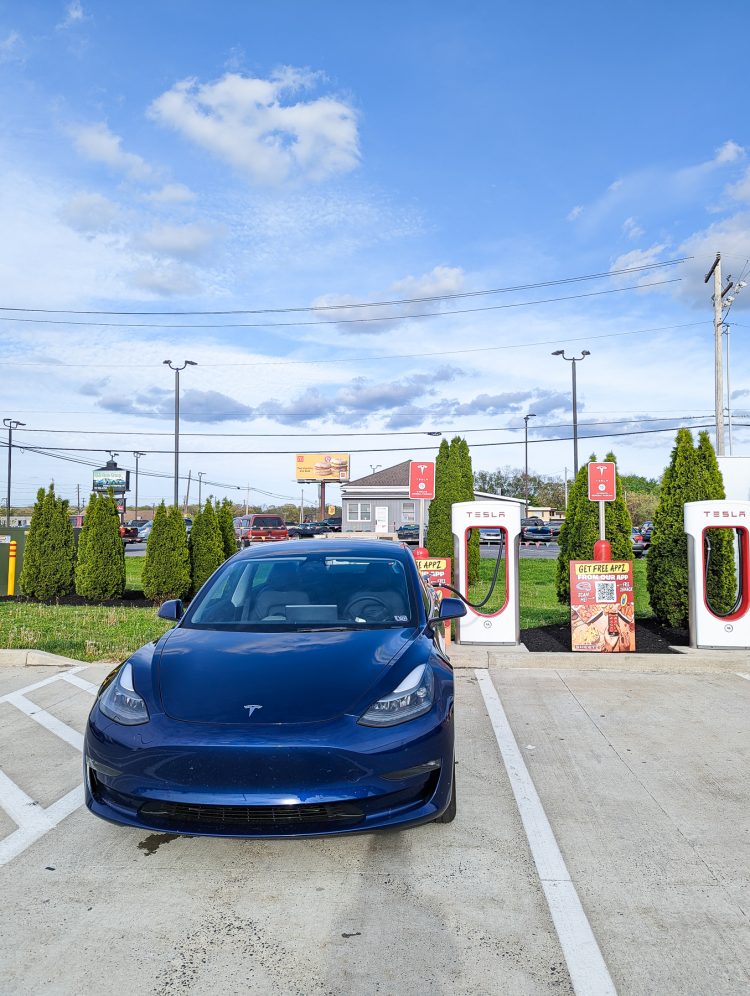
Did you know we got a Tesla? A little over a month ago, we finally received our long-range Tesla Model 3 that we ordered back in the fall. Driving an electric car, especially a Tesla, is a whole different experience than driving a conventional internal combustion engine (ICE) car.
I am working on a full review of our first few months driving an electric vehicle as a family, but let’s suffice to say that there’s a bit of a learning curve. Here are the cliff notes of the review:
It’s fast. It’s amazing. Everyone who drives it loves it. And it’s well worth the investment of time to learn how to live “the electric car life” (even if it’s not a Tesla). But we don’t currently have sufficient infrastructure for everyone to drive electric… yet.
Our First Family Road Trip in An Electric Car
About five weeks after picking up our Tesla from the store, we set out for our first family road trip in an electric vehicle, an endeavor complete with its own learning curve and considerations.
I look forward to the day when most of us drive electric cars, so I don’t want to scare you off. A road trip in an electric car is not hard, but it’s also not the same as a road trip in a gasoline-powered car. Taking our electric car out of its battery range for the first time did involve a bit of planning, just to get used to the functionality of the car and the slightly different cadence of a road trip in an electric car. Now that we’ve done it once, it’s fairly easy for most road trips, especially those that are just a handful of hours.
Our first road trip was a 300-mile adventure, just me and my ten-year-old son, across the great state of Pennsylvania. In pursuit of a youth hockey competition, we hopped into our long-range Tesla Model 3 and drove from Philadelphia to Pittsburgh for a weekend tournament.
While I was admittedly a little nervous as we set out on the drive, and proceeded with extra caution to ensure we didn’t run out of battery life, one road trip made me feel significantly more comfortable taking the Tesla out of its battery range under certain circumstances.
I’ve received a series of questions from curious friends about how we executed our road trip that exceeded the range of the car’s battery. I want you to feel comfortable bringing an electric car into the mix for your family and help you understand how it may or may not impact the cadence of your routine driving. So let’s dive into all the questions about how to take a family road trip in an electric car.

Can You Really Take a Family Road Trip in an Electric Car?
Yes. Definitively yes. It is possible to take a road trip in an electric vehicle in the United States. We did it, and we will do it several more times over the next few months.
That being said, there are some challenges, especially if you drive a non-Tesla electric vehicle. (Tesla has far more charging stations that are only available to Tesla drives currently, though there is speculation Tesla may open their fleet of Superchargers to more types of EVs in the future. They have already done this in Europe.)
Challenges of taking a road trip in an electric vehicle may include slow chargers, not enough chargers, chargers that are too spread out, variations in battery life depending on weather, remote locations of some chargers, and more. These difficulties aren’t complete barriers to taking a road trip in an electric car, but they certainly pose unique challenges that you won’t face in a gas-powered car today.
All of these problems ultimately stem from an underdeveloped charging station infrastructure (present in some parts of the country but not an issue in places like California). As I alluded to above, Tesla has a far more robust network of charging stations, especially fast-charging Superchargers, so many Tesla drivers seem to have an easier and more pleasant experience taking a road trip in their EV than non-Tesla drivers. It’s precisely the reason we chose to buy a Tesla instead of a different brand.
Regardless of the car brand, many of these issues should resolve themselves if the United States government invests heavily in EV charging station infrastructure as expected based on funding bills already passed through Congress.
So yes. You can take a road trip in an electric vehicle. You may need to do a bit of planning, and it will be meaningfully easier in a Tesla right now than in another type of EV. Let’s dive into our recent family road trip in our long-range Tesla Model 3.
Planning Ahead For a Road Trip in an Electric Vehicle
A few days before our trip, I researched charging station locations on our travel route. I found several charging stations that allowed us to stop every 100 to 150 miles to recharge.
Although the car has a maximum range of over 300 miles per battery charge, this range is effective only under ideal driving conditions. The battery functions most effectively in urban settings when you drive at slower speeds with plenty of breaking (not the high-speed highway driving of a road trip).
I wanted to be especially careful, so I ensured we could charge at Tesla Superchargers often enough that I wouldn’t get anywhere near the end of our battery life. While I don’t know the exact battery range when most of the trip is highway driving, I wouldn’t anticipate more than about 225-250 miles between charges (just my conservative estimate).
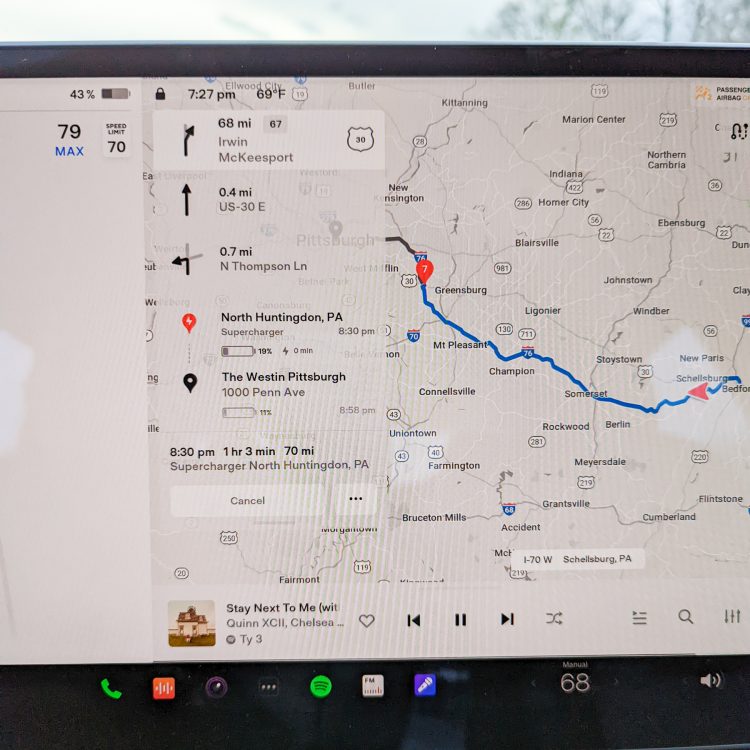
Using The Smart Navigation with Charging Functionality
No matter which brand of EV you drive, you can search for charging stations on sites like Google Maps, EV charging station map sites like PlugShare, and charging network apps like ChargePoint and EVConnect. However, some EV cars (like Tesla) have native smart navigation systems built into the car that include charging station stops on a navigation route as needed.
Before taking our Tesla out of its battery range, I researched charging stations using the third-party map functions I mentioned above. I wasn’t yet comfortable with the Tesla smart navigation as my only source of information and wanted to be particularly conservative. What happens when your EV battery dies on the side of the road? I didn’t want to find out (and to be honest, I’m still not sure).
The websites were fine, but the Tesla smart navigation seemed to have many charging stations in the database that I didn’t find easily on third-party maps (or even on the Tesla map on their website).
In the future, I will just put the destination address into the navigation system in the car while at home a few days before we leave and use the car’s smart navigation system to ensure adequate charging options during travel. It is easier and seems more effective than online alternatives.
I still felt most comfortable researching charging stations in and around Pittsburgh before I left, so I could have tentative charging plans as backup options. But the Tesla smart navigation works exceptionally well. Having taken just one road trip with it, I feel totally confident taking road trips in our electric car.
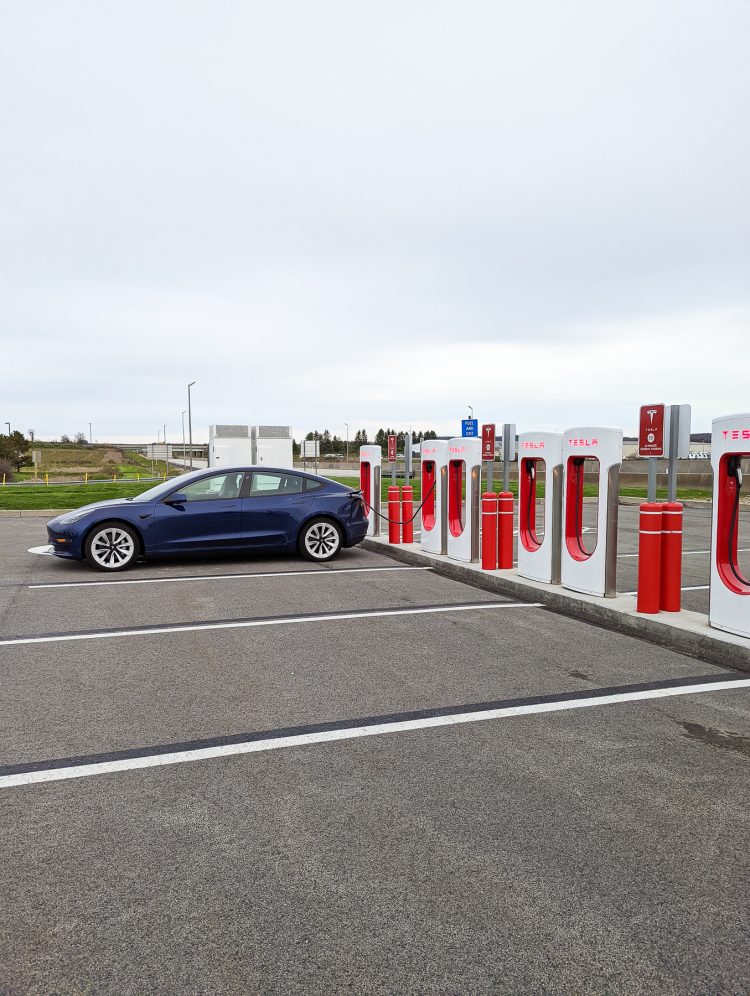
Charging the Electric Car During the Road Trip
Charging the electric car during the 300-mile drive proved even easier than I anticipated. As we left Pittsburgh to journey home, I simply put our home address into the smart navigation system before we left. The navigation system calculated mileage and automatically added stops right on our travel route to charge.
In our case, we needed to stop twice to charge in order to get home. Both of the charging stations included in the travel route were located at service areas on the Pennsylvania Turnpike, so we did not even have to exit the turnpike to recharge.
The smart navigation system even tells you how long to charge at each destination to accumulate sufficient battery and if you have to stay below any speed limits in order to preserve sufficient battery life for the trips between charging stations.
Although I was a bit hesitant to use the smart navigation before trying it out when I did not fully understand how it worked, it was so easy!
Charging the Electric Car While At Our Travel Destination
Aside from charging during travel between Philadelphia and Pittsburgh, we charged the car twice during our time in Pittsburgh. Our hotel offered a free Level 2 Tesla charger included in the cost of parking at the hotel. A Level 2 charger takes about 8-10 hours to fully recharge the battery. On the first night, we let the car charge overnight and had a full battery when we woke up the next morning.
The night before we left to go home, we planned to charge the car at the hotel again. However, another car used the charger all night, so we had to make alternative plans. We stopped at a grocery store that had Tesla Superchargers and charged for 15 minutes while we went inside and got breakfast. This quick stop in the morning gave us enough battery life to get to a charging station along the Pennsylvania turnpike on the way home.
Advertised Battery Ranges Are Under Ideal Driving Conditions
Much like mileage per gallon of gas estimates for ICE cars, the advertised maximum battery lives for electric cars only apply under ideal driving conditions. Effectively, the battery life estimation can be slightly overstated for real-life driving circumstances. This applies particularly to long road trips because high-speed driving without breaking drains the battery more quickly than urban driving.
In many instances, when we departed a destination, the projected battery life upon planned arrival at our destination (according to the smart navigation system) was usually 1% to 2% higher than the actual battery life when we arrived at the charging station or our final destination. In other words, we used a bit more battery life than the navigation system anticipated.
These variances may be a function, at least in part, of my driving habits. However, battery usage is also impacted by changes in temperature, driving speeds and conditions, and other circumstances.
Thus, much like driving in a regular ICE car with gasoline, it’s best not to save a trip to the charging station or gas station until the very last drop of battery life or gasoline, respectively. Further, batteries do not operate optimally at less than 10% battery charge, so the car’s alert system will aggressively encourage you to charge the battery as soon as you drop below 10% remaining battery life.
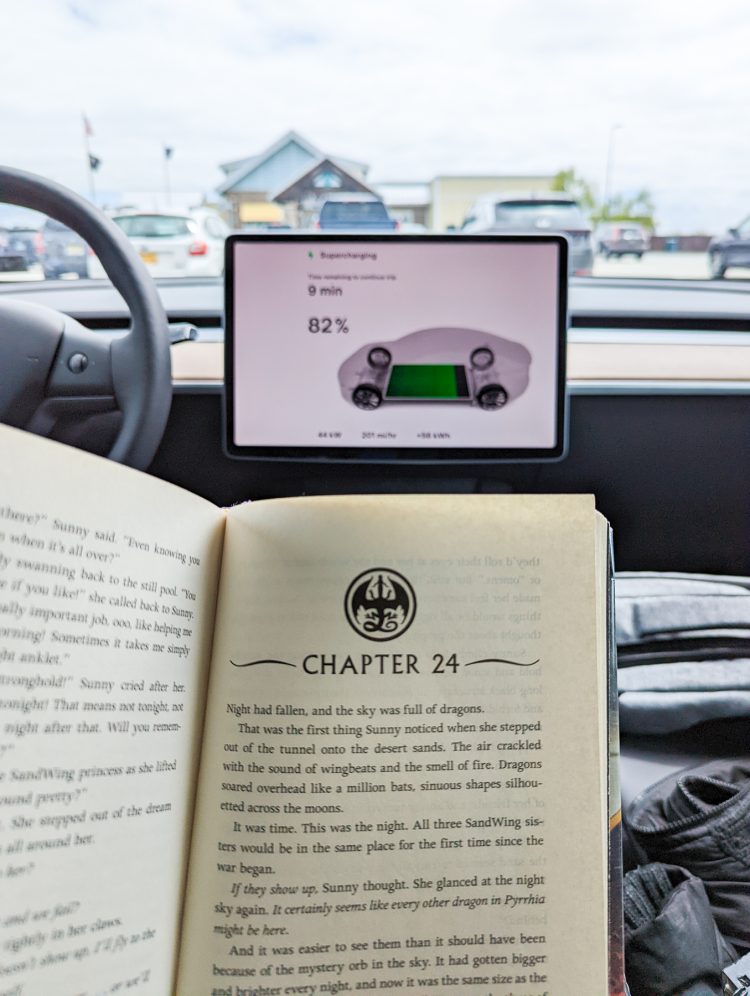
Added Time To Roadtrip Travel
Many people wondered how much extra time the travel took because we stopped to charge. We would have stopped for food, a bathroom break, and gasoline in a traditional car. All in, driving an electric vehicle on our 300-mile road trip resulted in about 20 extra minutes of travel time (over a five-hour trip) relative to driving a regular gasoline-powered car.
If you have the time, the charging breaks aren’t all bad. We had a bit of extra time to eat and stretch our legs. And I even read a book to my son in the car for about twenty minutes while we waited for the charge to finish, which may have been his favorite part of the travel.
Fees To Charge Our Electric Vehicle
At home, we often charge the car battery using the charger in our garage, so the cost to charge our car while we are home becomes an element of our monthly utility bill. Away from home, this is obviously not available. Instead, we charged at public charging stations, some that were Tesla Superchargers and some that were generic charging stations.
Charging stations can be free or cost money to charge, depending on who owns and manages them, and how they decide to provide the charging service to the community. We used chargers that had a variety of fee (or free) payment structures.
For our first stop, we charged up at a Tesla Supercharger (Level 3 – DC Fast) at a gas station for which we paid a fee. This set of chargers also charged an Idle Fee if you sat at the charger after the car reached a full battery (and “full” was really only 80% battery life due to automated restrictions at this set of chargers). Busy charging stations often have idle fees to prevent people from blocking charging stations when they aren’t using them.
We used a Level 2 charger at our hotel, the fee for which was included in the parking rate. We used a Tesla Supercharger at a grocery store and paid $5.60 for about a 25% charge. A growing number of businesses and retailers provide free EV charging in the hopes of drawing more customers to the store. but most Level 3 (aka DC Fast) chargers demand too much electricity so these are not subsidized.
We also used two Tesla Superchargers at rest stops along the Pennsylvania turnpike between Philadelphia and Pittsburgh. We paid $23.04 to full charge a nearly empty battery. Then we paid $7.25 for a second partial charge before heading home.
During the course of the trip, we paid a total of $53.57 for charging fees. This same drive would have used well over $100 worth of gasoline in our regular sedan and likely closer to $150 of gas in our SUV.
As electric cars become more popular, I expect some free charging stations to start charging for use. There will simply be too many electric cars for businesses to sustain electricity expenses for so many customers. But for now, it’s a nice benefit of being an early adopter. I also anticipate we will see more DC Fast chargers because mainstream drivers won’t tolerate sitting at a single location (other than their home or place of employment) to charge for several hours.
How To Pay For Charging Stations
When we did have to pay for chargers, they were really easy to use. Generic charging stations require a credit card (and sometimes an app on your phone) to process payment. Tesla Superchargers identify the car when it’s plugged in and charge the Tesla driver’s account directly (the company maintains credit card information in your account).
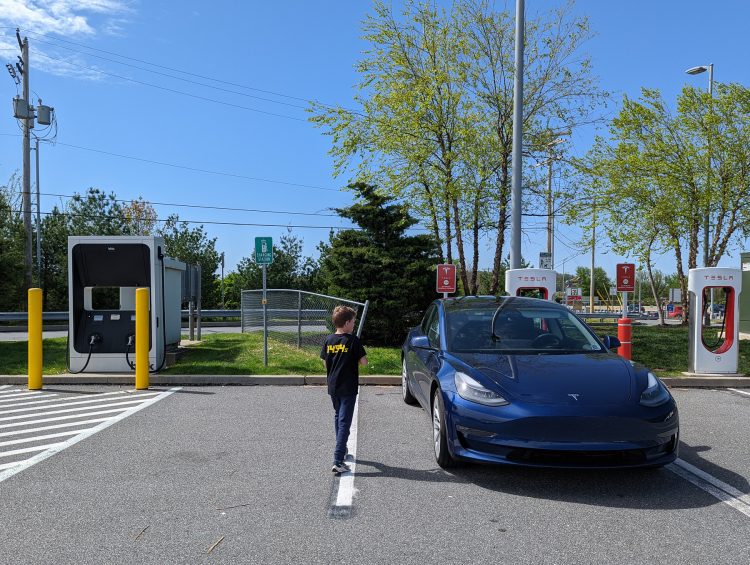
Tesla Superchargers, Tesla Level 2 Chargers, and Generic Charging Stations
Charging Station Levels (How Fast Can You Charge)
There are three classes of charging options to power up an electric car, conventionally called Levels 1, 2, and 3. While I’m sure an engineer could get much more technical about the differences, here’s the general gist about different charging options for your electric vehicle.
Level 1 outlets are regular outlets you use at your home, where you might charge your laptop or your cell phone. They typically add about 3-4 miles of charge to your battery per hour. There are also Level 1 charging stations available for public use that offer the same level of charge as the standard plugs in your home.
Level 2 chargers offer more power and add about 25-30 miles per hour to an EV battery. These are some of the most common types of chargers you’ll find. This is what we used at the hotel. The home charger we have is a Level 2 charger as well.
Level 3 (also called DC Fast) chargers are super fast chargers. They aren’t all Tesla Superchargers, but this category includes the Superchargers. You can charge a full EV battery in under an hour. If you’re planning to take a road trip and travel more than the range of your battery in a day, you’ll definitely need to find some Level 3 chargers to juice up.
Charging Station Brands (What Car Brands Can Use Them)
Currently, in the United States, there are two types of charging stations: Tesla and generic. Tesla charging stations only service Tesla vehicles. Other brands of electric cars are not currently compatible with Tesla chargers. Generic chargers (often part of charging networks) are compatible with any electric vehicle brand including Tesla.
One of the main reasons we ultimately chose Tesla over other electric vehicle brands was the more robust Tesla charging station infrastructure in the northeast United States. While our analysis was anecdotal, we saw far more Tesla specific-chargers than generic chargers.
Currently, Tesla Superchargers only work for Tesla vehicles. However, Elon Musk (head of Tesla) has alluded to future changes that would allow all cars to use Tesla charging stations. Tesla has already made this change in many places in Europe.
Additionally, the United States government has dedicated significant funding to building out more charging station infrastructure, and this would most likely be primarily for generic charging stations that benefit a larger population.
I can’t foresee the United States government using tax dollars to subsidize charging stations dedicated to one brand of electric vehicles, especially when that brand caters to higher-income citizens. Even as a Tesla driver, I don’t think that would be fair or appropriate. So I anticipate that we will soon see a much more robust network of charging stations for all types of electric vehicles in the next couple of years.
Was a family road trip in an electric vehicle easy?
For us, our road trip was very easy. But as I mentioned earlier, I think it depends on the type of car you’re driving and where you are going. Given the volume of Tesla Superchargers, a road trip beyond the range of a car’s battery feels easier (to me) in a Tesla than in other electric vehicles currently. I hope and expect this will change for non-Tesla vehicles soon given the United States government’s large anticipated investment in charging station infrastructure.
Our trip was also relatively short and through areas of sufficiently dense populations, so we knew we could find plenty of Level 3 charging stations along our travel route.
Contemplating a cross-country road trip, however, left me curious about just how robust the charging station network is. Could I road trip through areas like the southwest United States (relatively sparse population) in an electric vehicle?
Testing the road-tripping limits of my Tesla Model 3, I entered my sister’s address in the smart navigation system in the Tesla. She lives in San Diego, so driving to her house would take us 2,345 miles from Philadelphia, Pennsylvania to San Diego, California, a trip across most of the United States and through some very remote areas.
According to Tesla’s smart navigation system, I could make this cross-country trip. It would require 15 stops at Superchargers along the way in Pennsylvania, Ohio, Indiana, Illinois, Missouri, Oklahoma, Texas, New Mexico, Arizona, and California. So… I guess I could make it!
Although I haven’t done the research, I’m not sure if I could make the trip from Philadelphia to Pittsburgh or to San Diego in an electric vehicle other than a Tesla. I suspect I could do it, but I’m not sure how easy or relaxing it would be. I saw a couple of generic charging stations at some of the Pennsylvania Turnpike service areas but not all of them. Some of the service areas included Tesla Superchargers but not generic charging stations.
I think Tesla has been intentional about placing charging stations across the United States to facilitate long-distance travel. However, without coordination of a particular company thus far (or possibly the US government in the future), I wonder if generic charging station infrastructure has yet been designed to support long-distance travel more broadly. If not, it’s highly unlikely one could get across the country effectively in a non-Tesla electric vehicle today.
Growing Awareness & Curiosity of Electric Vehicles
The most interesting aspect of taking our road trip in a Tesla was answering all the questions we received from friends and strangers alike. Both times that we charged at Pennsylvania Turnpike stops, someone approached me with much curiosity about “the whole deal” and “how it all worked.”
At the first stop, a very skeptical truck driver asked me all sorts of questions about how the car worked, how I turned it on, if I had a key, and how much it cost to charge my car at home and on the road. He was familiar with the Tesla brand but seemed primarily connected to the prospect of self-driving Tesla semi-trucks. As you might imagine, self-driving tractor-trailers look like a lot of lost jobs to truck drivers and, understandably, feel threatening.
He wasn’t too familiar with EVs for individual drivers. We talked about how brands other than Tesla make electric cars, and how they are becoming increasingly affordable for everyday people. Throughout the conversation, it was clear he wasn’t all that comfortable with what electric vehicles meant for the future of his profession and his community. But he was willing to ask and learn, and he offered me valuable perspective as well.
At the second service area, another curious man approached me while I plugged in our car to charge. The conversation was quite a bit shorter and he displayed much more interested curiosity and less skepticism than the first person. He just spent a few minutes walking around the car, checking out the charger, and generally gauging how this futuristic machine worked. He thought the car was more “cool” and less threatening.
For both of these conversations (and especially the first one), I did my best to channel Katharine Hayhoe. Hayhoe has become a respected climate communicator, advocating for and promoting the importance of having respectful and honest conversations about climate matters with those who don’t always agree with us.
I really appreciated the curiosity of both of the people who stopped to ask me questions and the chance to have conversations with people who have very different experiences and perspectives than me. I love having open conversations with people about my climate passions, even when they don’t agree with me (as long as they aren’t total jerks about it). And I truly love listening to others’ ideas and concerns because it helps me better understand what solutions will work best for the broadest group of Americans (and people around the world in general).
Above all, I especially respected the first man’s willingness to ask questions and talk to me when he could only assume I didn’t share his same skepticism of electric vehicles. I drive a Tesla after all; he knew I supported electric vehicles.
I left that conversation thinking that, while it felt uncomfortable (in a difference of opinion sense – not a safety sense), we need to keep having more of these conversations. I taught him a lot about electric vehicles and he taught me a lot about why people outside of my community have very real and valid reservations about an important climate solution.
Can you imagine yourself taking a road trip in an electric vehicle?
After having our Tesla for a couple of months, we unequivocally love it. It’s fast. It’s fun. It drives well. It’s awesome to not have to stop at the gas station (and even better that we don’t have to pay for gas). We can definitely take a family road trip in an electric vehicle. But we also still have the luxury of owning an ICE vehicle as well when the EV isn’t our preferred option.
If you’re thinking about getting an EV, don’t be afraid of road trips. You can definitely do it, and it’s only going to get easier. If you’re looking for especially long road trips, know there might be some unique considerations around which to plan before hopping in the car for a run-of-the-mill journey.
And if you’re thinking more generally about choosing an electric vehicle for your family, know that nearly (if not all) of your driving needs are accessible in an electric car. This especially applies if you have two cars, like many American suburban families, and one of those cars is still an ICE car.
I’d love to know what other questions I can answer for you. What questions do you have about driving an electric vehicle with kids? How can I help you ease hesitations you might have about stepping into a car of the future (that’s really more a car of today).

Jen Panaro
Jen Panaro, founder and editor-in-chief of Honestly Modern, is a self-proclaimed composting nerd and advocate for sustainable living for modern families. To find her latest work, subscribe to her newsletter, Stepping Stones.
In her spare time, she’s a serial library book borrower, a messy gardener, and a mom of two boys who spends a lot of time in hockey rinks and on baseball fields.
You can find more of her work at Raising Global Kidizens, an online space to help parents and caregivers raise the next generation of responsible global citizens.







